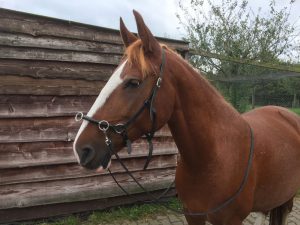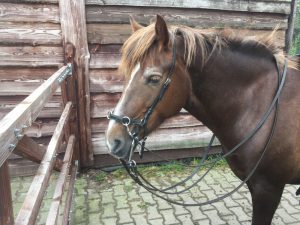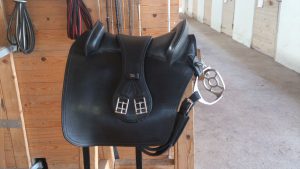Cavesson
A cavesson is a bitless bridle. Often a bicycle chain or a solid iron covered in leather is placed over the nose. There are also metal free alternatives. The advantage of a bicycle chain compared to a solid iron is that it can easily be used for different horses. A solid iron is formed after the horse you have, but is does not really fit horses with other nose profiles. A solid iron however, often slips less than a bicycle chain.
The cavesson may be an full bridle or simply a nose band, a riding cavesson, used together with your normal bridle. The nose band have 2-3 rings, and the middle ring is used in leading exercises, ground work and longeing, when only one rein is used whereas the two outer rings are used for riding or work in hand when two reins are needed.
Since the rings are placed over the nose, the reins are affecting the skull and you get a stelling effect. The reins can also be used to lift the horse’s head if it is too low. The cavesson and the snaffle bit have the same functions. The cavesson is traditionally used in the AAoR for leading exercises, ground work, longeing and when starting to ride the horse. Of course continued riding on the cavesson is possible, if you wish to use a bitless bridle.

Curb bit
The curb bit is straight barred and has a leverage effect. The shank lengths and the ratio between the upper and lower lever arms decide upon the sharpness of the curb. In the end, it is of course the hand that determines the sharpness. The mouthpiece is a straight bar, with or without a port to create freedom for the tongue, and the shanks may be straight or curved.
There is no stelling effect in the curb bit and it does not work to flicker your fingers in the bit as can be done with the snaffle bit. If a rein aid is given, it works in the whole bit and the horse gets an impulse to seek forward down. If the horse is too deep there is no lifting effect, but a complement with a cavesson or a snaffle bit must be made. Traditionally a cavesson and a curb bit is used in the AAoR until the horse is schooled enough to ride on only the curb.

Whips
A whip act as an extended arm, when your own arms do not reach the horse. It can be a good thing to have whips of different lengths, depending on training form. A long whip, like a carriage whip, can be good to use in the ground work and longeing to reach the horse properly without losing your own body language. If the whip is too short, it is easy to lean forward towards the horse, and if you actually wanted to pull your shoulder backwards, then you are sending contradictory signals, which confuses the horse. A shorter whip for riding is good, and this can also be used in ground work/longeing once the horse has learned the signals and understand the pointing of the whip without the physical contact. Why not go out into the forest and get yourself a twig or two to use as whips?

Saddle / saddle pad or bareback
Riding your horse bareback, with a saddle pad or saddle is partly a matter of taste and partly an economic issue. A good school saddle has the advantage that it helps you to sit correctly on the horse, but on the other hand, it can cost a lot of money to acquire. A saddle pad is built in sheepskin, fabric, foam or something similar and is a treeless construction that helps to keep you in place on the horseback. Finally, it is of course possible to ride bareback too. The advantage of riding bareback compared to riding in a saddle is that it is very easy to feel the movements of the horse, and you train your balance. My recommendation is to ride bareback rather than in an ill-fitting saddle.
